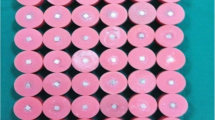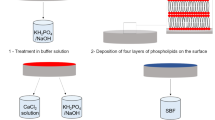Abstract
This study investigated changes in the roughness parameters (Sa in μm2 and Ra in μm) of yttrium-stabilized tetragonal zirconia polycrystal (Y-TZP) and large-grit sandblasted acid-etched (SLA) titanium (TI) materials after decontamination by erbium chromium-doped:yttrium, scandium, gallium, and garnet (Er,Cr:YSGG) laser irradiation. Twenty disks were analyzed in this study: 10 disks of Y-TZP (5 mm in diameter and 3 mm in height), standardized with CAD–CAM procedures, and 10 disks of SLA TI (5 mm in diameter and 4 mm in thickness). Disks were randomized into four groups (n = 5), according to whether laser irradiation was performed: Y-TZP_G1 and TI_G1 were not treated by laser (control groups), whereas Y-TZP_G2 and TI_G2 were irradiated with Er,Cr:YSGG laser (1.5 W/20 Hz, air–water cooling proportion of 80 %/25 %). The surface topography of the disks was analyzed by confocal light microscopy. The mean Sa and Ra values were calculated from five profiles from each group. The results were statistically analyzed by t-test at the 95 % confidence level (α = 0.05). For Y-TZP, the Sa results (in mean ± SD) for Y-TZP_G1 and Y-TZP_G2 were 2.60 ± 1.1 and 0.80 ± 0.17 μm2, respectively, and the Ra results were 2.01 ± 0.71 and 0.18 ± 0.15 μm, respectively (both p < .05). For SLA TI, the Sa results for TI_G1 and TI_G2 were 1.99 ± 0.5 and 3.37 ± 0.75 μm2, respectively, and the Ra results were 1.78 ± 0.53 and 3.84 ± 0.63 μm, respectively (both p < .05). Er,Cr:YSGG laser irradiation alters the surface roughness of zirconia and SLA TI.




Similar content being viewed by others
References
Al-Nawas B, Kämmerer PW, Morbach T, Ladwein C, Wegener J, Wagner W (2012) Ten-year retrospective follow-up study of the TiOblast™ dental implant. Clin Implant Dent Relat Res 14:127–134
Dierens M, Vandeweghe S, Kisch J, Nilner K, De Bruyn H (2012) Long-term follow-up of turned single implants placed in periodontally healthy patients after 16–22 years: radiographic and peri-implant outcome. Clin Oral Implants Res 23:197–204
Shibli JA, Mangano C, D'avila S, Piattelli A, Pecora GE, Mangano F, Onuma T, Cardoso L, Ferrari DS, Aguiar KC, Iezzi G (2010) Influence of direct laser fabrication implant topography on type IV bone: a histomorphometric study in humans. J Biomed Mater Res A 93:607–614
Dohan Ehrenfest DM, Coelho PG, Kang BS, Sul YT, Albrektsson T (2010) Classification of osseointegrated implant surfaces: materials, chemistry and topography. Trends Biotechnol 28:198–206
Schwarz F, Wieland M, Schwartz Z, Zhao G, Rupp F, Geis-Gerstorfer J, Schedle A, Broggini N, Bornstein MM, Buser D, Ferguson SJ, Becker J, Boyan BD, Cochran DL (2009) Potential of chemically modified hydrophilic surface characteristics to support tissue integration of titanium dental implants. J Biomed Mater Res B Appl Biomater 88(2):544–557
D'Avila S, dos Reis LD, Piattelli A, Aguiar KC, de Faveri M, Borges FL, Iezzi G, Oliveira NT, de Cardoso LA, Shibli JA (2010) Impact of smoking on human bone apposition at different dental implant surfaces: a histologic study in type IV bone. J Oral Implantol 36:85–90
Nakamura K, Kanno T, Milleding P, Ortengren U (2010) Zirconia as a dental implant abutment material: a systematic review. Int J Prosthodont 23:299–309
Andreiotelli M, Wenz HJ, Kohal RJ (2009) Are ceramic implants a viable alternative to titanium implants? A systematic literature review. Clin Oral Implants Res 20(Suppl 4):32–47
Denry I, Kelly JR (2008) State of the art of zirconia for dental applications. Dent Mater 24:299–307
Akyil MS, Uzun IH, Bayindir F (2010) Bond strength of resin cement to yttrium-stabilized tetragonal zirconia ceramic treated with air abrasion, silica coating, and laser irradiation. Photomed Laser Surg 28:801–808
Delgado-Ruíz RA, Calvo-Guirado JL, Moreno P, Guardia J, Gomez-Moreno G, Mate-Sánchez JE, Ramirez-Fernández P, Chiva F (2011) Femtosecond laser microstructuring of zirconia dental implants. J Biomed Mater Res B Appl Biomater 96(1):91–100
Stübinger S, Homann F, Etter C, Miskiewicz M, Wieland M, Sader R (2008) Effect of Er:YAG, CO(2) and diode laser irradiation on surface properties of zirconia endosseous dental implants. Lasers Surg Med 40(3):223–228
Subası MG, Inan O (2012) Evaluation of the topographical surface changes and roughness of zirconia after different surface treatments. Lasers Med Sci 27(4):735–742
Gahlert M, Röhling S, Wieland M, Eichhorn S, Küchenhoff H, Kniha H (2010) A comparison study of the osseointegration of zirconia and titanium dental implants. A biomechanical evaluation in the maxilla of pigs. Clin Implant Dent Relat Res 12(4):297–305
Zembic A, Sailer I, Jung RE, Hämmerle CH (2009) Randomized-controlled clinical trial of customized zirconia and titanium implant abutments for single-tooth implants in canine and posterior regions: 3-year results. Clin Oral Implants Res 20(8):802–808
Sailer I, Zembic A, Jung RE, Siegenthaler D, Holderegger C, Hämmerle CH (2009) Randomized controlled clinical trial of customized zirconia and titanium implant abutments for canine and posterior single-tooth implant reconstructions: preliminary results at 1 year of function. Clin Oral Implants Res 20(3):219–225
Bremer F, Grade S, Kohorst P, Stiesch M (2011) In vivo biofilm formation on different dental ceramics. Quintessence Int 42(7):565–574
Shibli JA, Melo L, Ferrari DS, Figueiredo LC, Faveri M, Feres M (2008) Composition of supra- and subgingival biofilm of subjects with healthy and diseased implants. Clin Oral Implants Res 19:975–982
Lang NP, Berglundh T (2011) Peri-implant diseases: where are we now? — Consensus of the Seventh European Workshop on Periodontology. J Clin Periodontol 38(Suppl 11):178–181
Shibli JA, Theodoro LH, Haypek P, Garcia VG, Marcantonio E Jr (2004) The effect of CO(2) laser irradiation on failed implant surfaces. Implant Dent 13:342–351
de Mendonça AC, Máximo MB, Rodrigues JA, Arrais CA, de Freitas PM, Duarte PM (2008) Er:YAG laser, ultrasonic system, and curette produce different profiles on dentine root surfaces: an in vitro study. Photomed Laser Surg 26(2):91–97
Schwarz F, Sculean A, Rothamel D, Schwenzer K, Gerog T, Becker J (2005) Clinical evaluation of an Er:YAG laser for nonsurgical treatment of peri-implantitis: a pilot study. Clin Oral Implant Res 16(1):44–52
Takasaki AA, Aoki A, Mizutani K, Kikuchi S, Oda S, Ishikawa I (2007) Er:YAG laser therapy for peri-implant infection: a histological study. Lasers Med Sci 22(3):143–157
Hauser-Gerspach I, Stübinger S, Meyer J (2010) Bactericidal effects of different laser systems on bacteria adhered to dental implant surfaces: an in vitro study comparing zirconia with titanium. Clin Oral Implants Res 21(3):277–283
Romanos GE, Gutknecht N, Dieter S, Schwarz F, Crespi R, Sculean A (2009) Laser wavelengths and oral implantology. Lasers Med Sci 24(6):961–970
Stübinger S, Etter C, Miskiewicz M, Homann F, Saldamli B, Wieland M, Sader R (2010) Surface alterations of polished and sandblasted and acid-etched titanium implants after Er:YAG, carbon dioxide, and diode laser irradiation. Int J Oral Maxillofac Implants 25(1):104–111
Gonçalves F, Zanetti AL, Zanetti RV, Martelli FS, Avila-Campos MJ, Tomazinho LF, Granjeiro JM (2010) Effectiveness of 980-mm diode and 1064-nm extra-long-pulse neodymium-doped yttrium aluminum garnet lasers in implant disinfection. Photomed Laser Surg 28(2):273–280
Kreisler M, Al Haj H, Götz H, Duschner H, d'Hoedt B (2002) Effect of simulated CO2 and GaAlAs laser surface decontamination on temperature changes in Ti-plasma sprayed dental implants. Laser Surg Med 30(3):233–239
Romanos GE, Everts H, Nentwig GH (2000) Effects of diode and Nd:YAG laser irradiation on titanium discs: a scanning electron microscope examination. J Periodontol 71:810–815
Geminiani A, Caton JG, Romanos GE (2011) Temperature increase during CO(2) and Er:YAG irradiation on implant surfaces. Implant Dent 20:379–382
Quaranta A, Maida C, Scrascia A, Campus G, Quaranta M (2009) Er:YAG laser application on titanium implant surfaces contaminated by Porphyromonas gingivalis: an histomorphometric evaluation. Minerva Stomatol 58(7–8):317–330
Azzeh MM (2008) Er,Cr:YSGG laser-assisted surgical treatment of peri-implantitis with 1-year reentry and 18-month follow-up. J Periodontol 79(10):2000–2005
Miller RJ (2004) Treatment of the contaminated implant surface using the Er,Cr:YSGG laser. Implant Dent 13(2):165–170
Romanos G, Crespi R, Barone A, Covani U (2006) Osteoblast attachment on titanium disks after laser irradiation. Int J Oral Maxillofac Implants 21(2):232–236
Schwarz F, Nuesry E, Bieling K, Herten M, Becker J (2006) Influence of an erbium, chromium-doped yttrium, scandium, gallium, and garnet (Er,Cr:YSGG) laser on the reestablishment of the biocompatibility of contaminated titanium implant surfaces. J Periodontol 77(11):1820–1827
Ercan E, Arin T, Kara L, Candirli C, Uysal C (2013) Effects of Er,Cr:YSGG laser irradiation on the surface characteristics of titanium discs: an in vitro study. Lasers Med Sci. doi: 10.1007/s10103-013-1294-5
Shibli JA, Marcantonio E, d'Avila S, Guastaldi AC, Marcantonio E Jr (2005) Analysis of failed commercially pure titanium dental implants: a scanning electron microscopy and energy-dispersive spectrometer X-ray study. J Periodontol 76:1092–1099
Subramani K, Wismeijer D (2012) Decontamination of titanium implant surface and re-osseointegration to treat peri-implantitis: a literature review. Int J Oral Maxillofac Implants 27:1043–1054
Kamel MS, Khosa A, Tawse-Smith A, Leichter J (2013) The use of laser therapy for dental implant surface decontamination: a narrative review of in vitro studies. Lasers Med Sci. doi:10.1007/s10103-013-1396-0
Galli C, Macaluso GM, Elezi E, Ravanetti F, Cacchioli A, Gualini G, Passeri G (2011) The effects of Er:YAG laser treatment on titanium surface profile and osteoblastic cell activity: an in vitro study. J Periodontol 82:1169–1177
Acknowledgments
The authors would like to thank TitaniumFIX, São Paulo, Brazil, for supplying the Y-TZP and titanium disks. The authors thank Ms. Sheila Schuindt do Carmo (LCT POLI-USP-Technology Characterization Laboratory, University of São Paulo, Brazil) for the technical support with confocal microscopy.
Disclosure
The authors have no interest in any of the companies or products mentioned in this article.
Author information
Authors and Affiliations
Corresponding author
Rights and permissions
About this article
Cite this article
Miranda, P.V., Rodrigues, J.A., Blay, A. et al. Surface alterations of zirconia and titanium substrates after Er,Cr:YSGG irradiation. Lasers Med Sci 30, 43–48 (2015). https://doi.org/10.1007/s10103-013-1516-x
Received:
Accepted:
Published:
Issue Date:
DOI: https://doi.org/10.1007/s10103-013-1516-x




